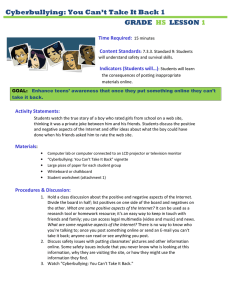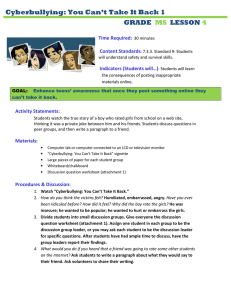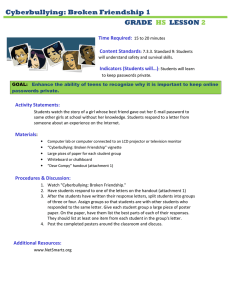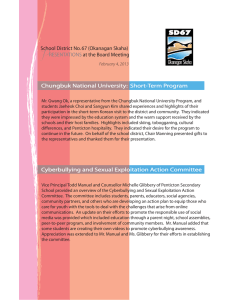• Page 3 - Discussion Points (click on #`s to reveal questions)
advertisement
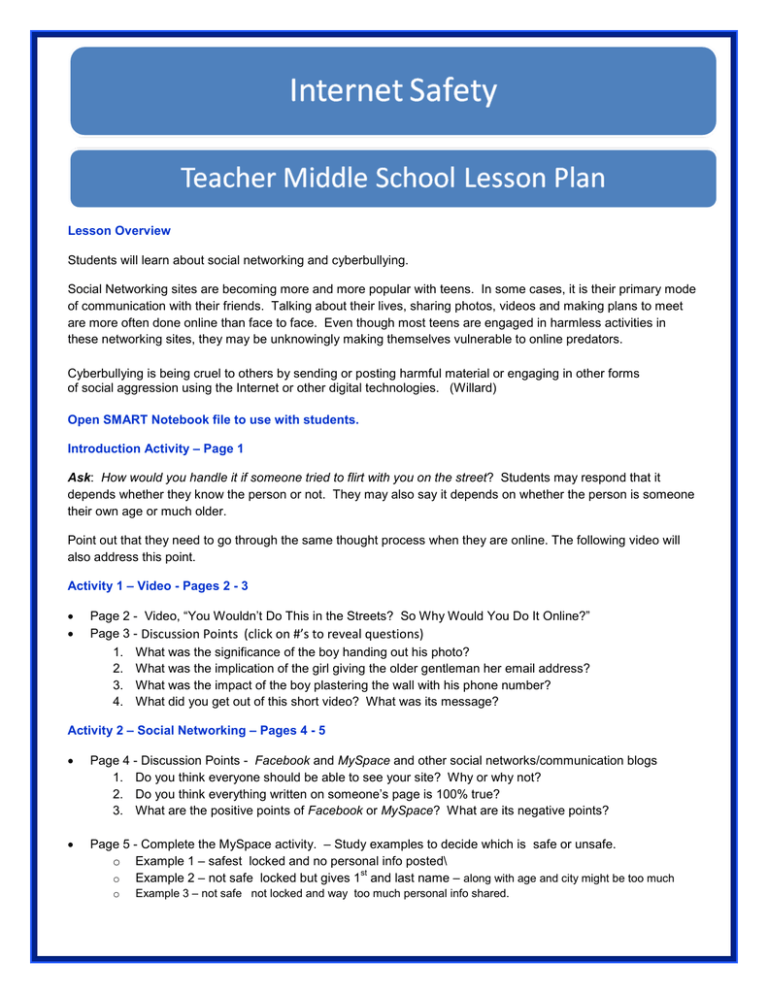
Lesson Overview Students will learn about social networking and cyberbullying. Social Networking sites are becoming more and more popular with teens. In some cases, it is their primary mode of communication with their friends. Talking about their lives, sharing photos, videos and making plans to meet are more often done online than face to face. Even though most teens are engaged in harmless activities in these networking sites, they may be unknowingly making themselves vulnerable to online predators. Cyberbullying is being cruel to others by sending or posting harmful material or engaging in other forms of social aggression using the Internet or other digital technologies. (Willard) Open SMART Notebook file to use with students. Introduction Activity – Page 1 Ask: How would you handle it if someone tried to flirt with you on the street? Students may respond that it depends whether they know the person or not. They may also say it depends on whether the person is someone their own age or much older. Point out that they need to go through the same thought process when they are online. The following video will also address this point. Activity 1 – Video - Pages 2 - 3 • • Page 2 - Video, “You Wouldn’t Do This in the Streets? So Why Would You Do It Online?” Page 3 - Discussion Points (click on #’s to reveal questions) 1. What was the significance of the boy handing out his photo? 2. What was the implication of the girl giving the older gentleman her email address? 3. What was the impact of the boy plastering the wall with his phone number? 4. What did you get out of this short video? What was its message? Activity 2 – Social Networking – Pages 4 - 5 • Page 4 - Discussion Points - Facebook and MySpace and other social networks/communication blogs 1. Do you think everyone should be able to see your site? Why or why not? 2. Do you think everything written on someone’s page is 100% true? 3. What are the positive points of Facebook or MySpace? What are its negative points? • Page 5 - Complete the MySpace activity. – Study examples to decide which is safe or unsafe. o Example 1 – safest locked and no personal info posted\ st o Example 2 – not safe locked but gives 1 and last name – along with age and city might be too much o Example 3 – not safe not locked and way too much personal info shared. Activity 3 – Cyberbullying – Pages 6 - 9 • • • • Page 6 - Allow students to share what Cyberbullying means to them. Page 7 - Explain to students the formal definition of cyberbullying: o intentional and repeated use of computer and cell phone networks by kids and teens to cause harm or distress to other kids and teens. Read the following paragraph to students. o Cyberbullying can make you feel angry, frustrated, sad, or fearful—especially when you don’t know who is sending the harassing messages. Sometimes kids use language that says they want to hurt someone. When this kind of language comes in the form of an electronic message—an e-mail, instant message, or text message over computers or cell phones—it’s hard to tell whether it is serious or not. No matter how a message is sent, words that say you intended to hurt someone are taken very seriously by schools, parents, and the police. Page 8 Read the scenario titled, “Cyberbullying: Crossing the Line, “about Eric, Alexis, and the electronic messages. o Possible discussion questions about “Cyberbullying: Crossing the Line” How do you think Eric feels? What about this situation is making him feel this way? How do you think Alexis felt when she got Eric’s message? Eric is probably very distressed—and rightly so—by the repeated anonymous cruel messages and that Alexis cannot be sure from Eric's message whether he is just angry or if he intends to physically harm her What should Alexis do? What could Eric have done instead of sending the message to Alexis? What should the other kids who knew about the messages Eric was getting have done? Alexis should report the cyberthreat to the school and her parents, that Eric could have asked adults for help before he reached the point of making an angry threat, and that the students who knew what was going on should have supported Eric and reported the cyberbullying. • Page 9 - Video titled, “Cyberbullying: You can’t Take it Back” This is a true story of a boy who rated girls from school on a web site, thinking it was a private joke between him and his friends. o Possible discussion questions about “Cyberbullying: You Can’t Take it Back.” How do you think the victims felt? Humiliated, embarrassed, angry Have you ever been ridiculed before? How did it feel? Why did the boy rate the girls? He was insecure; he wanted to be popular; he wanted to hurt or embarrass the girls. What would you do if you heard that a friend was going to rate some other students on the Internet? Closure – Page 10 Resources http://www.cybersmartcurriculum.org/ www.netsmartz.org http://firewall.wikispaces.com/ http://new.csriu.org/cyberbully/cbbook.php Willard, Nancy E. "Responding to the Challenge of Online Social Aggression, Threats, and Distress." Cyberbullying and Cyberthreats N.p., n.d. Web. 14 Dec. 2009. http://new.csriu.org/cyberbully/cbbook.php.
